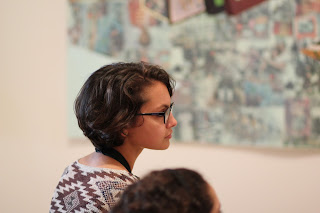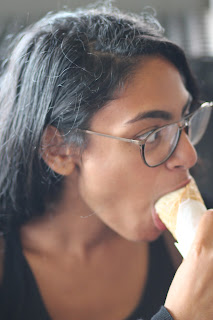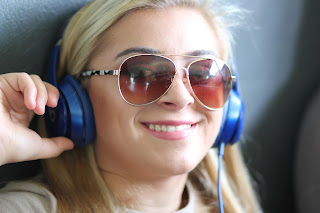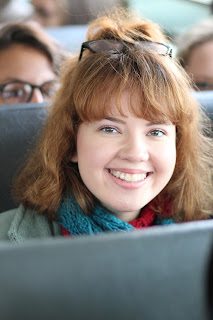Assignment: Read the assignments listed below and choose one assignment to be completed each semester in your journal. Your response to the assignments you choose should be at least 10 sentences long.
- You are Beautiful: Tell 5-10 people they are beautiful and most importantly, tell them why they are beautiful. Be specific and don’t give repeat reasonings for multiple people. Document your findings in your journal including:
- Name and visual representation of each person (photo, sketch, or a symbolic memento)
- How did that person react?
- Additional thoughts, stories, conclusions about the activity?
2. Don’t Be Hatin’: In our post-ironic world, it is easier than ever to say all manner of nasty and judgmental things without even thinking. Outside of class, you will act as a sociologist and listen to the people around you to take note of just how much, how often and how extreme the language flows around you.
OBSERVE:
Take about 3 listening blocks (about 5 minutes each) in a variety of settings e.g. cafeteria, hallways, sports events, work, home etc. to take note of hate speech - hateful language, insults, obscenity, racial epithets, or any other manner of speech that demeans others. ( A few examples can be greeting each other with senseless cursing, describing things as "gay" or "retarded", thinking it's "okay" to drop a racial slur because "you're friends" with that person.)
RECORD:
1) Where did you do the listening? Write it down! OR Sketch the place!
2) For each location, jot down some of the words, phrases, sentences that you noticed. Add check marks next to the repeats so that you can provide some quantitative data (that's information with numbers)
for example:
LOCATION 1 LOCATION 2 LOCATION 3
phrase word phrase
and so on....
REFLECT:
After you have done your observing and collecting, think about:
Select a minimum of THREE questions to answer in your journal:
- How do you feel about this speech?
- Has your awareness changed?
- Do you have a reaction? Does this surprise, sadden, sicken, or stimulate you in any way?
- Can you figure out why the person is using that word?
- Is it to make themselves feel bigger? To fit in, to show off? Because they are racist?
- Are you doing a disservice to humanity by not confronting people for casually using terms that are racist, misogynist, and just overall intolerant of others?
- Is there a reason why we do this? (You don’t need to know the answer to this question.)
- How does your observation and recording activity inform or compare with your own use of hate speech?
3. Cutting the Cord: Go an entire day without the use of electronics. This means you cannot touch or look at a phone, tablet, TV, computer, or any piece of technology! Answer 3 of the following questions in your journal:
- Was abstaining from the use of technology hard or easy for you? Explain why.
- Was there any point in time throughout the day that you felt overcome by the urge to use technology? Be specific and describe this instance.
- Did you take notice to things happening around you that you might not have noticed otherwise if you had access to your technology?
- After going a day without using electronics, what was the first electronic item you picked up after completing this assignment? Would you say this electronic item is your most cherished? Explain why or why not.
- After going a day without using electronics, do you feel like you missed out on anything major? Like a breaking news story, an important status update, a funny snap story, etc.?
- Read this New Yorker article: “The Pointlessness of Unplugging”
“This is why it’s strange to think of these unplugging events as anything like detox: the goal isn’t really abstinence but a return to these technologies with a renewed appreciation of how to use them. Few who unplug really want to surrender their citizenship in the land of technology; they simply want to travel outside it on temporary visas.”
Does unplugging from technology for a day give you a newfound appreciation for it? Explain why or why not. Is it hard for you to imagine that hand-held technology like we have today was at one time not nearly as ubiquitous?
4. Try A Different Cuisine: Consider a type of cuisine that you have never tried before or perhaps a kind of cuisine that you were always too afraid to try. Go to a restaurant or to your local grocery store and try something new! Document it in your journal with pictures, mementos, maybe even a menu! Answer the following questions below:
- Did you enjoy it?
- Would you eat it again?
- How would you describe this cuisine to someone who hasn’t tried it before?
- Was it difficult to find a type of food to try? Or to choose a dish to try?
- Why do you think you have never tried cuisine like this before?
5. Stranger In A Strange Land: Attend a religious service not of your own faith, sit at a different lunch table for a week, or find another way to immerse yourself in another culture (eating a different cuisine doesn’t count for this entry - unless it is part of a larger submersion).
Record: Document your experience with writing, drawings, and/or photos.
Reflect: What was the overall experience like?
Did you feel uncomfortable? If so, why do you think you did? Did it pass?
What did you learn?
How does this compare to your normal experiences?
Did you make any new friends?
Reflect: What was the overall experience like?
Did you feel uncomfortable? If so, why do you think you did? Did it pass?
What did you learn?
How does this compare to your normal experiences?
Did you make any new friends?
What will you take away from this experience?
6. Right Where You Are Sitting: Write ten sentences describing where you are sitting right now. Maybe these are things you hadn’t noticed when you first sat down. Use your senses. What do you see? What does it smell like where you are? What do you hear? Consider what you know about where you are sitting. Who else has sat where you are sitting? Do not censor anything that you write. When you complete this, draw one object that you can see in the room where you are sitting.
7. Small Thoughts: Make a list of 15 placid small thoughts you have throughout the week. For instance, what were you thinking just now? What thoughts have you had about school, your family, your friends, the food you ate, a dream you had, an interaction you had with a stranger, etc. Record these thoughts in your journal.
8. Dream Diary: Keep a record of at least five dreams that you can remember in your journal. Try to be as specific as you can. Please use illustrations, comic strips, and/or pictures along with your writing to document what happened in your slumber-time. For each dream, analyze what you believe occurred and why. It isn’t essential to believe that your dream has a hidden meaning, but at least explore why you think certain images, people, situations and storylines were structured the way they were.
Tips on Remembering Dreams:
To dream, you have to sleep. So sleep.
Try to purposely change when you sleep and when you wake up. Setting your alarm clock to an earlier time, even by five minutes, can interrupt a dream-state and make it easier to remember.
Put pen to paper as soon as you wake. Keep a notebook by your nightstand and scribble notes about what you can recall. Don't assume that you will continue to hold on to a dream while you get ready for school. The longer you wait - even a few minutes - the less you will actually remember.

































































